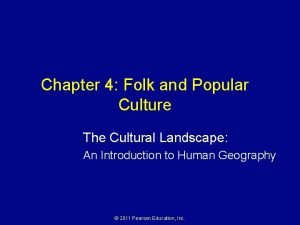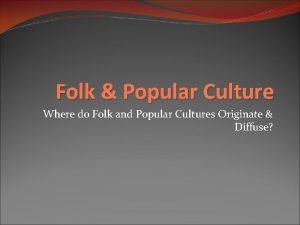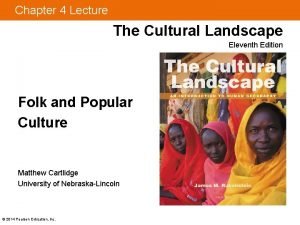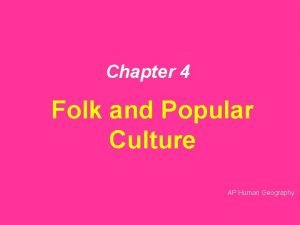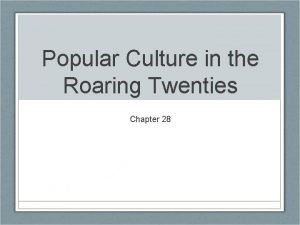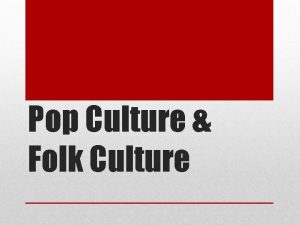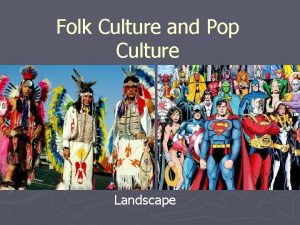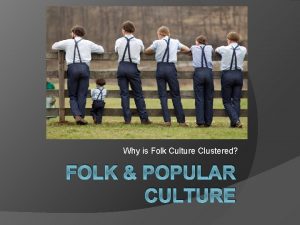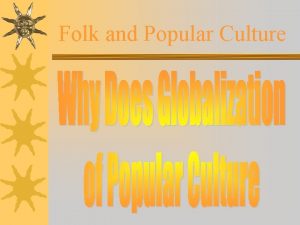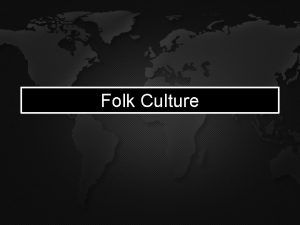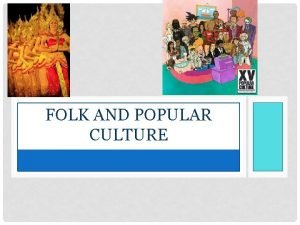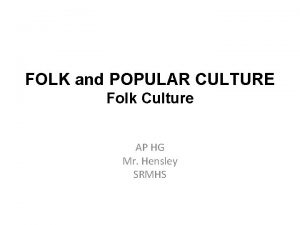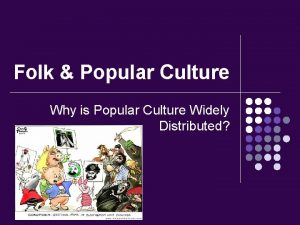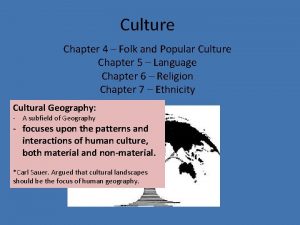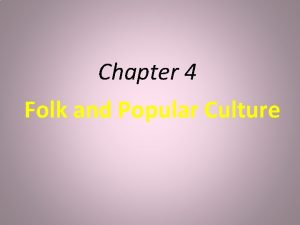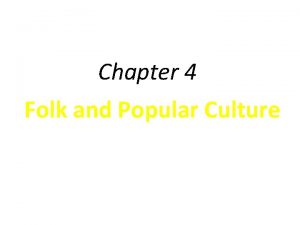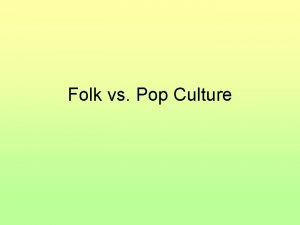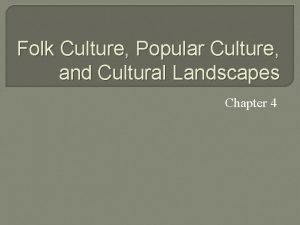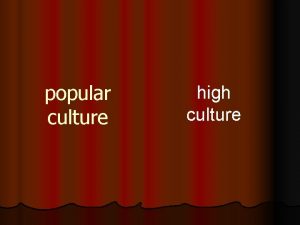Chapter 4 Folk and Popular Culture AP Human























- Slides: 23

Chapter 4 Folk and Popular Culture AP Human Geography

Origins and Diffusion of Folk and Popular Cultures • Culture: A group of belief systems, norms, and values practiced by people. • Folk culture: small, incorporates a homogeneous population, is typically rural, and is cohesive in cultural traits. • Pop culture: large, incorporates heterogeneous populations, typically urban, and experiences quick changes in cultural traits.

Folk Culture vs. Popular Culture

Popular Culture: Food, music, dance, clothing, entertainment

Popular Celebrities

In Popular Culture: Trends Hierarchical diffusion Example: Fashion Starts at the point of origin: Milan, Paris, New York Major fashion houses: LA, Hollywood etc. Shopping mall

Distance Decay: the likelihood of diffusion decreases as time and distance from the hearth increases. Hearth Time Space Compression: the likelihood of diffusion depends upon the connectedness among places: communications and transportation technologies.

Commodification The process through which something—a name, a good, an idea or even a person—that previously was not regarded as an object to be bought or sold. . Becomes an object that can be bought, sold, and traded in the world market.

Convergence of Cultural Landscapes Convergence of cultural landscapes has three dimensions: 1. Particular architectural forms and planning have diffused around the world 2. Individual businesses and products have become so widespread that they now leave a distinctive landscape stamp on far flung places 3. The wholesale borrowing of idealized landscape images, though not necessarily fostering convergence, promotes a blurring of place distinctiveness

Mc. Donalds World Wide Locations •

Wide Dispersion of Popular Culture • Diffusion of popular housing, clothing, and food – Popular housing styles – Rapid diffusion of clothing styles – Popular food customs • Television and diffusion of popular culture – Diffusion of television – Diffusion of the internet – Government control of television

Clustering of Folk Cultures • Influence of the physical environment – Distinctive food preferences – Folk housing – U. S. folk house forms

Amish Settlements in the U. S. Fig. 4 -4: Amish settlements are distributed through the northeast U. S.

Home Locations in Southeast Asia Fig. 4 -7: Houses and sleeping positions are oriented according to local customs among the Lao in northern Laos (left) and the Yuan and Shan in northern Thailand (right).

House Types in Western China Fig. 4 -8: Four communities in western China all have distinctive house types.

Diffusion of House Types in U. S. Fig. 4 -9: Distinct house types originated in three main source areas in the U. S. and then diffused into the interior as migrants moved west.

Diffusion of New England House Types Fig. 4 -10: Four main New England house types of the eighteenth and nineteenth centuries diffused westward as settlers migrated.

U. S. House Types, 1945– 1990 Fig. 4 -11: Several variations of the “modern style” were dominant from the 1940 s into the 1970 s. Since then, “neo-eclectic” styles have become the dominant type of house construction in the U. S.

U. S. House Types by Region Fig. 4 -1 -1: Small towns in different regions of the eastern U. S. have different combinations of five main house types.

Diffusion of TV, 1954– 1999 Fig. 4 -14: Television has diffused widely since the 1950 s, but some areas still have low numbers of TVs per population.

Distribution of Internet Hosts Fig. 4 -15: The U. S. had two-thirds of the world’s internet hosts in 2002. Diffusion of internet service is likely to follow the pattern of TV diffusion, but the rate of this diffusion may differ.

Impacts of the Globalization of Popular Culture • Threats to folk culture – Loss of traditional values – Foreign media dominance • Environmental impacts of popular culture – Modifying nature – Uniform landscapes – Negative environmental impact

Words to Know Culture Folk Culture Popular Culture Local Culture Hierarchical diffusion Hearth Assimilate Custom Commodification Distance Decay Time-Space Compression
 Folk culture and popular culture venn diagram
Folk culture and popular culture venn diagram Chapter 4 folk and popular culture
Chapter 4 folk and popular culture Homework due today
Homework due today Ap human geography songs
Ap human geography songs Folk and popular culture
Folk and popular culture Chapter 4 folk and popular culture
Chapter 4 folk and popular culture Folk and popular culture
Folk and popular culture How do the origins of folk and popular culture differ?
How do the origins of folk and popular culture differ? How does folk culture diffuse
How does folk culture diffuse Why is access to folk and popular culture unequal
Why is access to folk and popular culture unequal Popular culture definition ap human geography
Popular culture definition ap human geography Chapter 13 section 3 education and popular culture
Chapter 13 section 3 education and popular culture Chapter 13 section 3 education and popular culture
Chapter 13 section 3 education and popular culture Chapter 28 popular culture in the roaring twenties
Chapter 28 popular culture in the roaring twenties Chapter 19 section 1 postwar america
Chapter 19 section 1 postwar america Folk culture definition and examples
Folk culture definition and examples Media pop culture
Media pop culture Pop culture of the 1950s
Pop culture of the 1950s Folk customs usually originate from
Folk customs usually originate from Pop vs folk culture
Pop vs folk culture Folk culture sports
Folk culture sports Lower chesapeake house style
Lower chesapeake house style Folk food definition
Folk food definition Why is folk culture clustered?
Why is folk culture clustered?




